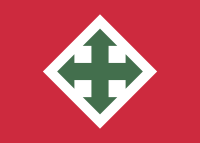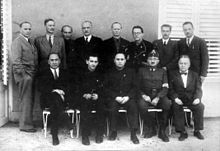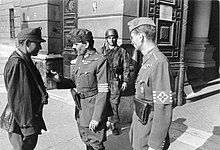Arrow Cross
The Arrow Cross or Hungarists ( Hungarian : nyilasok ) were the supporters of a fascist and anti-Semitic party in Hungary under various names from 1935 to 1945 . Their party leader was Ferenc Szálasi . With the support of the Third Reich , the Arrow Cross members set up a fascist collaboration government and dictatorship from October 16, 1944 to March 28, 1945 in parts of Hungary not yet occupied by the Red Army , under which tens of thousands of people were murdered.
Ferenc Szálasi founds a party
The various successive governments under the conservative imperial administrator Miklós Horthy did not pursue a unified line against right-wing extremist tendencies in the country. The parties founded by Ferenc Szálasi were repeatedly banned, but a re-establishment under a different name was not prevented. From 1935 to 1937, the Party of the National Will (Hungarian: Nemzeti Akarat Pártja , or NAP for short ) existed as Szálasi's first party, which is considered the predecessor party of the Arrow Cross. After it was banned by the government of Kálmán Darányi by state decree on April 15, 1937, a new party was founded through the merger of several National Socialist parties under Szálasi's leadership, which already had the arrow cross as a party symbol. The Arrow Cross Party then existed under the following names:
- Hungarian National Socialist Party (Hungarian: Magyar Nemzeti Szocialista Párt , MNSZP for short ); founded on October 24, 1937, banned on February 21, 1938.
- National Socialist Hungarian Party - Hungarist Movement (Hungarian: Nemzeti Szocialista Magyar Párt - Hungarista Mozgalom , short NSZMP - HM ); Founded on March 27, 1938, renamed to on August 1, 1938
- Hungarian National Socialist Party - Hungarist Movement (Hungarian: Magyar Nemzeti Szocialista Párt - Hungarista Mozgalom , MNSZP - HM for short ); banned on February 23, 1939.
- Arrow Cross Party (Hungarian: Nyilaskeresztes Párt , NYKP for short ); founded on March 15, 1939, banned on August 24, 1944, then re-registered as
- Arrow Cross Party - Hungarist Movement (Hungarian: Nyilaskeresztes Párt - Hungarista Mozgalom , NYKP-HM for short )
The symbol
After the Hungarian Interior Minister Ferenc Keresztes-Fischer banned the Gömbös government from using the swastika in September 1933, new symbols spread throughout Hungary's flourishing right-wing national party landscape. The numerous groupings, splinter groups and small parties were operated under frequently changing names by "party leaders" mostly in the form of one-man companies.
The green scythe cross (kaszáskereszt) became the symbol of the "National Socialist Hungarian Workers 'Party" (Nemzeti Szocialista Magyar Munkáspárt) by Zoltán Böszörmény , the likewise green arrow cross (nyilaskereszt) became the symbol of the "Hungarian National Socialist Peasants' and Workers 'Party" (Magyar- Socialist Peasant and Workers' Party. " Párt) by Zoltán Meskó . The followers of the respective groups were called Scythe Cross (kaszások) or Arrow Cross (nyilasok) in colloquial language . The Arrow Cross believed in its symbolism on a banner of King I. Ladislaus recourse. Szálasi only used the arrow cross symbol in a manner analogous to the swastika symbol of the NSDAP after the merger of various splinter groups and parties from 1937 .
history
Emergence
According to Stanley Payne , Hungary was at the top of all European states in the interwar period in terms of the number of fascist, semi-fascist or right-wing extremist movements, measured by population. Payne explains this by the fact that Hungary was the most nationally disadvantaged country in Europe because of its territorial and demographic losses after the First World War as a result of the Treaty of Trianon . Second, Hungary was the second country to be briefly ruled by a revolutionary communist dictatorship, the 1919 regime of Béla Kun . Thirdly, measured by the limited development of its social structure, the country had a large unemployed middle class, which included many advocates of such a policy.
During the economic crisis, new political organizations of the fascist type grew in Hungary, often bearing the name "National Socialist". A tiny National Socialist Party had already emerged in the 1920s. In 1931, Zoltán Böszörmény founded a National Socialist Hungarian Workers' Party, whose members were called Scythe Cross because of their emblem. She attempted to introduce the Nazis' original social program in Hungary, particularly targeting landless farm workers. In 1933 three new National Socialist parties were founded. The only ones who developed special activities in a nationwide framework were Böszörménys Sensenkreuzler, who, with their earlier orientation towards agricultural workers, chose May 1, 1936 as the date of an attempted coup. That venture failed, its leader fled abroad and 87 of his followers were tried and sentenced to prison terms.
The only noteworthy fascist movement in Hungary was the organization of the Arrow Cross or Hungarists founded by Ferenc Szálasi . Szálasi had a party of the national will as early as 1935 , but it only got one candidate through in the parliamentary elections. His party was the first to focus primarily on urban areas. In the summer of 1937, several National Socialist parties joined Szálasi and formed a general Hungarian National Socialist Party in October. The Hungarian government, now seeing National Socialism as a real danger, arrested Szálasi and 77 other activists in February 1938. On August 1, 1938, another small party joined Szálasi's general Hungarian National Socialist Party - Hungarist Movement, now commonly known as the Arrow Cross. The party salute was “Kitartás!” (German: “Persevere!”).
Activity from 1938 to 1944
A former Jewish citizen's palace (today's museum “ House of Terror ” in Budapest) on the lush, leafy avenue - Andrássy út - served the Arrow Cross members as party headquarters from 1939 to 1944 under the name “House of Loyalty”, including torture cellars in the basement. The Arrow Cross Party achieved its greatest success in the Hungarian parliamentary elections in 1939. It received 900,000 votes (around 25 percent) and had 250,000 party members, but was never part of a government until October 15, 1944, even though Hungary had been occupied by Germany in March 1944. As a result, the Eichmann Command, in cooperation with the Hungarian authorities and the gendarmerie, ghettoized 470,000 Jews in the enlarged Hungarian state territory and deported them to Auschwitz . The ideological support of the Arrow Cross was not decisive.
Collaboration regime (October 1944 - March 1945)
It was only after the attempt by the government under Reich Administrator Miklós Horthy to conclude a separate peace with the Allies had failed that the Arrow Cross took over the leadership of a government coalition in October 1944 after a putsch supported by the German occupation (see company Panzerfaust ). It was the last satellite regime that Hitler founded, and only the third to come under direct national fascist leadership.
With their help, the second wave of deportations of the Holocaust planned by the Germans was to be carried out in November 1944, as a result of which 76,000 Jews were deported. However, as the means of transport failed due to the war, the Jews were sent on death marches on foot towards the Austrian border. Two thirds of them perished during the death marches, in concentration camps, or while excavating. At the end of November, the marches from Szálasi were stopped because he requested means of transport with which the Jews could be deported. The final end of the deportations, however, in no way meant easing the situation for the Hungarian Jews. Crammed together in ghettos, they fell victim to the most brutal acts of violence by marauding Arrow Cross members.
Immediately after the Arrow Cross took power in October 1944, thousands of Hungarian Jews were shot on the banks of the Danube. The Hungarian historian Krisztián Ungváry speaks of 2,600 to 3,600 Jews who were murdered in this way. Massacres took place all over Budapest , for example on January 12, 1945 in the Jewish hospital on Maros Street, when around 90 doctors were shot by a group of Arrow Crossers. As in Croatia , some priests excelled in the killings. One Father Kun admitted that he murdered around 500 Jews. He usually commanded, “In the name of Christ - fire!” Women also took an active part in the mass murders .
In total, the number of Jewish deaths under the Szálasi regime amounts to around 50,000 people. South of the Hungarian Parliament in Budapest, on the lower Danube Quay, a Holocaust memorial was erected by the artist Gyula Pauer in collaboration with the film director Can Togay : Shoes on the Danube Bank . In memory of the shootings of 1944/45, sixty pairs of metal shoes were lined up over a length of 40 meters.
ideology
The Arrow Cross ideology was directed equally against the traditional conservatives and the “new right”, which in 1936 lost its most prominent representative in Gyula Gömbös . In contrast to them, Szálasi did not confess to Italian fascism , but to German National Socialism . The Hungarian variant of the Arrow Cross, "Hungarism", was to be implemented in the entire Danube-Carpathian region. The envisaged Greater Hungarian fatherland was to be based on Christianity and a racial hierarchy that excluded the Jewish minority. The economic program envisaged a corporate order based on private property, but also the nationalization of cartels, credit, the defense industry and energy companies. In domestic politics, the Arrow Crossers strived for a new mobilization dictatorship, which was to emerge from a revolutionary uprising of large sections of the population, based on the example of the German National Socialists.
literature
Monographs
- Miklós Lackó: Arrow-Cross Men, National Socialists, 1935-1944 (= Studia historica Academiae Scientiarum Hungaricae. Volume 61). Budapest 1969.
- Éva Teleki: Nyilas uralom Magyarországon: 1944 October 16 - 1945 April 4 . Kossuth Könyvkiadó, Budapest 1974.
- Margit Szöllösi-Janze : The Arrow Cross Movement in Hungary. Historical context, development and rule (= studies on contemporary history. Volume 35). De Gruyter, Berlin / Boston / Oldenbourg, Munich 1989, ISBN 3-486-54711-9 (dissertation University of Munich, 1985/1986, 499 pages).
- Sándor Márai : writer and European. Diaries 1 and 2, 1943–1945 , edited and annotated by Ernö Zeltner. Piper-Verlag, Munich 2009. The diaries 1943–1945 by Sándor Márai are particularly intensive readings on the subject of the Arrow Cross . “They are rather a 'literary parade ground' on which Márai goes to court with the Hungarian bourgeoisie, which is still in March 1945 watched without protest as the fascist Arrow Cross members drove 600,000 Jews to the Nazi extermination camps. ” In 2010, too, Márai's description of Hungarian anti-Semitism shook the reviewer Franz Haas.
Contributions from collective works
- Regina Fritz: An early documentation of the Holocaust in Hungary. The »Commission of Inquiry to Research and Publicize the Crimes committed by the National Socialists and Arrow Crossers« (1945). In: Zeithistorische Forschungen 14 (2017), pp. 352–368.
- Margit Szöllösi-Janze: Horthy Hungary and the Arrow Cross Movement. In: Geschichte und Gesellschaft 12 (1986), pp. 163-182.
- Margit Szöllösi-Janze: Arrow crossers, traitors and other enemies of the people - general accounting in Hungary. In: Klaus-Dietmar Henke, Hans Woller (ed.): Political cleansing in Europe. The reckoning with fascism and collaboration after World War II. dtv, Munich 1991, pp. 311-357, ISBN 3-423-04561-2 .
further reading
- Arnd Bauerkämper : Fascism in Europe 1918–1945. Reclam, Stuttgart 2006, ISBN 978-3-15-017049-6 .
- Enrico Deaglio: The banality of the good. The story of the impostor Giorgio Perlasca, who saved 5,200 Jews , Eichborn, Frankfurt am Main 1993, ISBN 3-8218-1150-1 .
- János Gyurgyák: Ezzé lett magyar hazátok - A magyar nemzeteszme és nacionalizmus története (History of the National Idea and Nationalism in Hungary), Budapest 2007 (Hungarian).
- Nina Gladitz , Perez Lorenzo: The Giorgio Perlasca Case. In: Dachauer Hefte , No. 7 (1991), ISSN 0257-9472 , pp. 129–143 ( ZDF documentary Perlasca from 1992)
Feature films
- The American feature film (judicial drama) Music Box from 1989 is about the atrocities of a Hungarian Arrow Cross member during the final years of the war in Hungary, who is charged with war crimes in an American court.
Web links
- Walldorf Concentration Camp : The Arrow Cross Party (Nyilaskeresztes Párt)
- "In Budapest, fascist rights remember the Arrow Cross members" ( Memento of September 8, 2007 in the Internet Archive ) (2004)
- Report on the "House of Terror" in Budapest ( Memento of March 26, 2009 in the Internet Archive ) (2004)
- Engerau camp
- “The Arrow Cross Coup” by Raoul Wallenberg
Individual evidence
- ^ Margit Szöllösi-Janze: The Arrow Cross Movement in Hungary. P. 440.
- ↑ János Gyurgyák: Ezze lett magyar hazátok. Budapest 2007, p. 253ff.
- ^ Payne: History of Fascism. P. 326.
- ^ Payne: History of Fascism. P. 331.
- ^ Payne: History of Fascism. P. 331ff.
- ↑ www.dradio.de, from April 12, 2008, Return of the Ghosts? ( online ).
- ^ Nation, Confession, History: on the national historical culture of Hungary - By Árpád von Klimó , p. 268 ( online ).
- ^ Payne: History of Fascism. P. 508.
- ^ Nations and their self-images: post-dictatorial societies in Europe - by Regina Fritz, Carola Sachse, p. 139 ( online ).
- ^ A b Igor-Philip Matić: Edmund Veesenmayer: Agent and diplomat of the National Socialist expansion policy. Munich 2002, p. 263.
- ^ Gregor Mayer, Bernhard Odehnal: Aufmarsch. The right danger from Eastern Europe. Residenz Verlag, St. Pölten / Salzburg 2010, p. 28.
- ^ Gerhard Botz, Stefan Karner: War. Memory. History. Vienna 2009, p. 324.
- ^ Gerhard Botz, Stefan Karner: War. Memory. History. Vienna 2009, pp. 324-325.
- ↑ Saul Friedländer, Martin Pfeiffer: The Third Reich and the Jews: The Years of Destruction, 1939–1945. Munich 2006, p. 670.
- ^ Margit Szöllösi-Janze: The Arrow Cross Movement in Hungary. P. 432.
- ^ Bauerkämper: Fascism in Europe 1918–1945. P. 147f.
- ↑ cf. Review note on Neue Zürcher Zeitung, September 4, 2010, reviewer Franz Haas https://www.perlentaucher.de/buch/sandor-marai/literat-und-europaeer-tagebuecher-band-1.html







